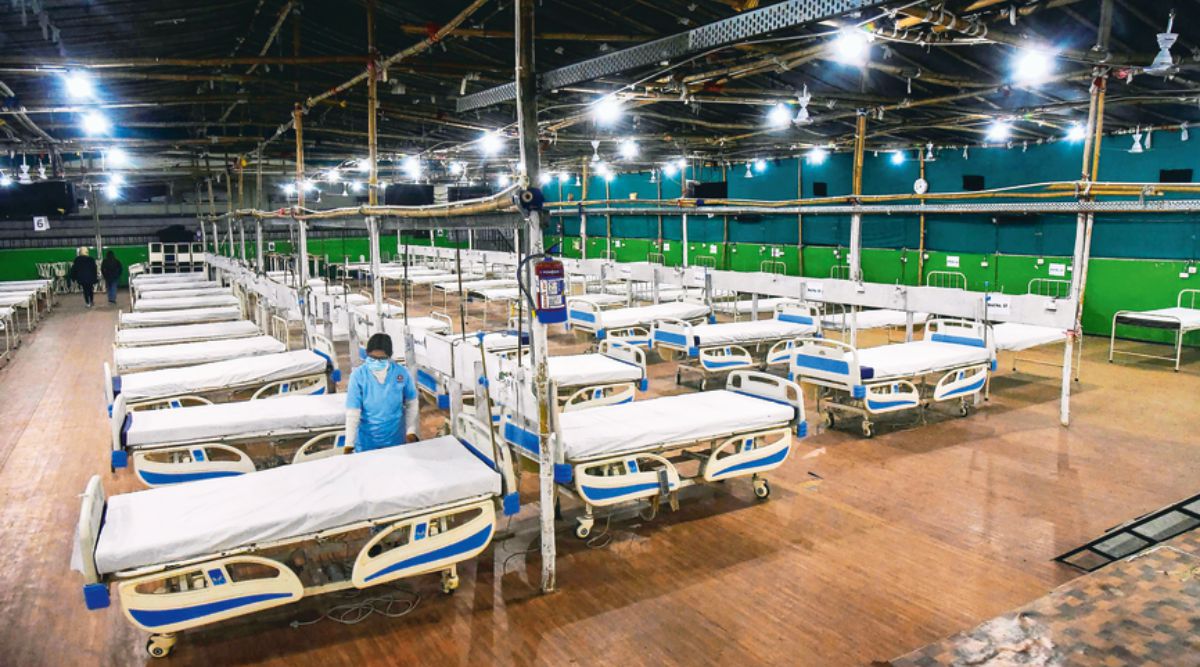 Beds being readied at a Covid isolation ward in Patna on Sunday. (PTI)
Beds being readied at a Covid isolation ward in Patna on Sunday. (PTI) WITH CASES of the Omicron variant of corona virus rising sharply, Union Health Minister Mansukh Mandaviya Sunday told states they have collectively utilised only over 17 per cent of the Rs 23,123 crore Emergency Covid-19 Response Package II (ECRP-II) to ramp up medical infrastructure approved by the Union Cabinet last August.
Mandaviya’s review meeting with state health ministers and senior officials in the state health departments came in the backdrop of India reporting 27,553 new cases in the last 24 hours and the cumulative active caseload touching 1.22 lakh. Just a week back, on December 26, India had reported just 6,531 cases, and the active case load was 75,841.
The Union Health Minister said other countries were witnessing “3-4 times the surge in Covid-19 cases in comparison to their earlier peaks” and noted that in India too, a “high surge in cases can overwhelm the medical system”. “…therefore, states (should) leave no stone unturned in ramping up infrastructure to manage a high surge so that India escapes unscathed from this episode of Covid-19,” Mandaviya said in the meeting.
“States/Union Territories were exhorted to expedite the physical progress under ECRP-II in terms of ICU beds, oxygen beds, Paediatric ICU/HDU beds. States/UTs were also urged to effectively use IT tools for tele-medicine and tele-consultation, including training and capacity building of human resources, timely availability of ambulances, the readiness of states to operationalise COVID facilities for institutional quarantining, and effective and supervised monitoring of those in home isolation,” the Union health ministry said.
In August last year, the Union Cabinet had approved a new Rs 23,123 crore India Covid-19 Emergency Response & Health System Preparedness Package: Phase-II (ECRP-II). According to the approved plan, and basis the inputs received by states given their experience on the second wave, the Centre approved the plan for creation of 23,056 ICU beds.
Under the plan, seven states were to set up more than 1,000 beds each: Uttar Pradesh (4,007), Karnataka (3,021), Maharastra (2,970), West Bengal (1,874), Tamil Nadu (1,583), Madhya Pradesh (1,138), and, Andhra Pradesh (1,120).
The rural parts of the country were one of the worst-hit during the peak of the ferocious second wave of the pandemic. Significantly, six states will get 60 per cent of the 75,218 beds that were to be set up to augment the three-tier healthcare system up to the village level. These six states, that will add more than 5,000 beds, at primary health care centres, secondary healthcare centres, and community health care centres in rural parts of the country, are Uttar Pradesh (11,770), Bihar (9,920), Andhra Pradesh (9,596), Odisha (8,206), Assam (7,320), and Jharkhand (5,798).
On December 15, during the review meeting on augmentation of medical oxygen supply, Union Health Secretary Rajesh Bhushan had informed the states that ECRP-II funds had been sanctioned for installation of 958 liquid medical oxygen storage tanks and medical gas pipeline systems in 1,374 hospitals. Also, 14,000 oxygen concentrators were being provided under the scheme.
Mandaviya discussed “critical bottlenecks in medical infrastructure” in the states, the health ministry said. “He urged the states to reinvigorate their teams to work at the ground level and strengthen monitoring and containment mechanisms. This was followed by a comprehensive and detailed discussion on various aspects of Covid management including ramping up of hospital infrastructure; increased testing; stringent restrictive measures for breaking the chain of transmission; and stress on Covid-appropriate behaviour among the masses,” the health ministry said.
A day before the roll-out of vaccines for the 15-18 years age group, Mandaviya asked states to ensure the orientation of vaccinators and team and the identification of dedicated session sites. The states were also asked to plan for distribution of Covaxin well in advance and publish sessions for at least 15 days to provide sufficient visibility, it being the only vaccine to be administered in this age group.
“To avoid the mixing-up of vaccines during administration, separate CVCs, separate session sites, separate queue (if at same session where adult vaccination is ongoing) and separate vaccination team (if at same session site) are to be strived for,” Mandaviya said, according to the health ministry.
- The Indian Express website has been rated GREEN for its credibility and trustworthiness by Newsguard, a global service that rates news sources for their journalistic standards.

